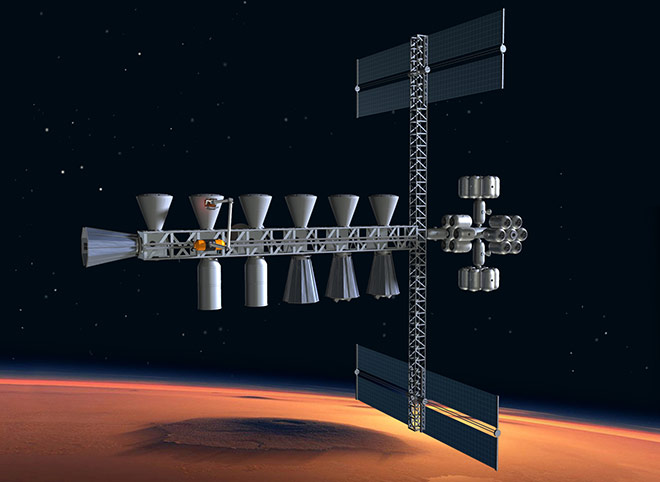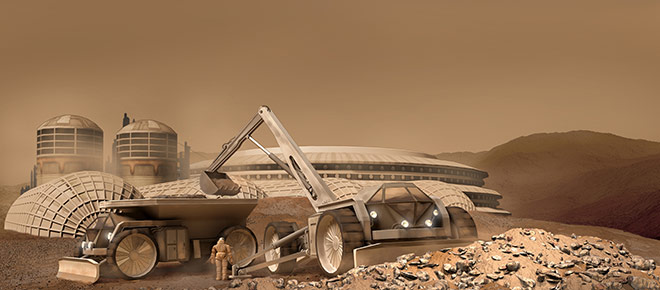- Part I: Introduction
- Part II: Milestones to All Destinations
- Part III: Utilization of Space Technology and Resources
- Part IV: To the Moon
- Part V: To Mars (this page)
- Part VI: To the Asteroids
- Part VII: To Orbital Space Settlements
- Part VIII: To the Stars
- Outline of the Roadmap
- PDF version of entire Roadmap (6 MB)
- Order full color print version

Reusable Martian ferries with propellant production and storage facility in the background. Art: Marcus Mashburn.
With a gravity one-third that of Earth’s and twice that of the Moon, an atmosphere one percent of the density of Earth’s, an axial tilt and a day-length very similar to Earth’s, and vital deposits of volatiles, Mars uniquely beckons to provide another world for humankind.
However, major Barriers specific to Mars will have to be overcome to reach the Milestones en route to the settlement of that planet. Those Barriers include:
Psychological and Political
Mars is a long way from Earth. With current technology it is more than a 6-month journey each way and, on account of orbital mechanics, pragmatically accessible from Earth for only a short launch window every two years. A single round trip would last either about 500 days, allowing only a short 30-60 day stay on the surface before the launch window for return to Earth would close (opposition mission), or about 900-1050 days, allowing 500 days for on-surface operations (conjunction mission). With trips so infrequent, lasting so long, and with relatively few or exciting on-surface events, public interest is likely to wane. Where public interest wanes, a decline in political support usually follows suit shortly thereafter. Therefore, any political decision to create a permanent and growing human presence on Mars will be almost a Milestone in itself.
Goal Definition
Early Mars exploration runs the risk of ending up as “flags and footprints” or “grab (rocks) and go” missions followed by the “been there-done that” lethargy that ended the Apollo lunar program. This risk will be lessened to the extent that, from the start, mission architectures are designed as a sustainable, reusable, integrated system that pursues ISRU and self-sufficiency technologies as the earliest goal, with ultimate settlement in mind.
Biological
As with the Moon, there are two major potential barriers to the permanent human settlement of Mars: radiation and gravity.
(1) While solar radiation is diminished on account of Mars’ distance from the Sun and Mars’ whisper-thin atmosphere, it still can be lethal to life on the surface. Extra-solar cosmic radiation would be undiminished. Methods to shield habitats and humans on the surface will have to be developed.
(2) Martian gravity, although twice that of the Moon, is still only one-third that of Earth. Whether terrestrial life can thrive and reproduce under such conditions is unknown. This Barrier can be tested by in-space variable-gravity centrifuges or by actual on-planet experience.
Uniquely Martian
Unique challenges of the Martian environment will have to be overcome — e.g., Martian dust, soil chemistry, shifting wind-blown dunes, accessibility of water, vehicle-trapping sand, acclimation to somewhat longer days.
MILESTONE 14: Robotic Exploration of Mars for Local (In Situ) Resources.
Satellites orbiting Mars and robotic landers determining the nature and extent of Martian resources, especially ice, guiding the choice of the best sites for follow-on human missions.
Robotic missions to Mars, both orbiters and landers, have provided tantalizing hints about Martian history and Martian geology. Continuing missions, utilizing the favorable launch windows that occur about every two years, may be entirely robotic or may be crewed missions to a Martian moon, from which the crew would (a) teleoperate Martian landers without the long delay in radio transmissions to and from Earth, (b) explore that moon, and (c) test equipment that later could be used on Mars.
There are two fundamental objectives of these missions.
1. Scientific Knowledge
One fundamental objective of these missions will be to continue to learn more and more about Martian history and geology, both to understand it for its own scientific value and to ascertain if there are any implications as to Earth’s own history and future. In particular, these missions will be searching for:
- Existing Martian life of any kind.
- Evidence of past Martian life, now extinct.
- Ice or buried liquid water, especially near the surface.
- Geological implications from diverse soil and rock samples.
- An understanding of Martian weather and seasons.
- Indications of any biological or other contaminants that could be harmful if returned to Earth.
- The best sites for follow-on human activities.
2. Data for Human Exploration and Outposts. The other fundamental objective of these robotic Mars missions will be to be ascertain existing conditions that are favorable and unfavorable to human exploration and settlement, especially near the Martian equator where less fuel is required to land and return to orbit. In particular, these missions will:
- Search for ice or water sources that will be the most accessible to humans.
- Search for brine and concentrations of other minerals that might be useful to humans.
- Test materials and machines against the Martian environment. For example they will want to learn whether and how — over long periods of time exposed to wind, dust, daily temperature changes, and seasonal changes — a wide variety of test materials will remain sturdy and machines workable. They will test how various mechanical equipment perform and hold up in that environment.
- Test various rover designs in ever longer traverses over varied Martian terrain.
- Test various in situ resource utilization (ISRU) equipment to automatically convert Martian air to rocket fuel.
- Test various energy supply systems.
- Test automatic digging equipment to automatically dig up and collect ice.
- Test automatic construction techniques both in and using Martian soil.
- Include mini-garden bubbles to test the ability of terrestrial plants to grow there.
With favorable launch windows existing only about every two years, determining the tradeoffs as to which measuring instruments and which test equipment and which rovers will be sent on any particular mission, and in what order, will provide challenges for policy makers.
Further Reading:
MILESTONE 15: Creation of a Logistics System for Transporting Humans and Cargo to the Martian Surface.
An integrated sustainable system designed and built for transporting humans and cargo from space to the Martian surface, maintaining the crew on the surface, and returning crew and payload safely back to Earth.

Mars way station with docking ports for propellant depots and crew and cargo ferries. Art: [email protected].
Reaching, landing on and returning from Mars, with its great distance from Earth, an atmosphere and a gravity twice that of the Moon’s, will be significantly more difficult than similar operations on the airless Moon. On account of that distance, equipment or supplies that fail on Mars cannot be easily replaced. An unexpected failure that might be recoverable from on the Moon, only a few days away from Earth, could be fatal on Mars. Consequently, materials destined for Mars should be especially well tested.
Decisions will have to be made as to which duration mission to undertake — a 500-day stay after a 6-month journey or just a 30-60 day stay — and that decision will drive the design of the transportation, landing, habitation and return systems.
Earth to Mars Transit Transportation Systems
Architectures proposed for the transportation systems needed to transit between Earth orbit and Mars orbit include single-launch systems or multiply launched vehicles, and includes vehicles assuming weightlessness during transit or vehicles using tether systems to create “artificial gravity.” Most systems contemplate using chemical propellants of one kind or another. Other proposed propulsion systems include nuclear-thermal propulsion and electric propulsion (e.g., ion, magneto-plasma-dynamic, arcjet). While the preferred goals and payload ought to be the determinants of the appropriate transportation system, the sequence may be just the opposite, with the choice of a transportation system determining the length or the trip, the resulting stay options at Mars, and the tonnage that can be brought. The choice of architecture will be influenced by the strength of the desire to have humans on Mars, tempered by the state and cost of then available technology. Reusable transit vehicles that can return to Earth orbit would reduce mission costs.
Earth Orbit to Mars Orbit on a “Cycler”
A cycling spacecraft that moves between the two planets in a regular period, without actually entering into orbit around Mars or Earth, would require less fuel and provide more protection for crews.
Mars Landing Systems. Many architectures have been proposed for such landings, such as:
- Earth (or Earth orbit) directly to the Martian surface (direct entry). Variations in landing systems include aero-braking (either with direct insertion from Earth or using multiple orbital passes), parachutes, braking rockets, or combinations of them.
- Earth (or Earth orbit) to orbit around Mars, and then to the surface of Mars (entry from orbit). Such systems generally will use a separate lander using one of the landing techniques considered for direct entry, with the mother ship remaining in orbit (crewed or not).
- Earth (or Earth orbit) to a landing on a Martian moon, and then to the surface of Mars with a separate lander.
Earth Return Systems. Similarly, various architectures have been proposed for the return to Earth, such as:
- Direct return from the Martian surface to Earth (or Earth orbit) using the original landing vehicle.
- Direct return from the Martian surface to Earth (or Earth orbit) using a separate return vehicle either attached to the original landing vehicle or pre-positioned in a previous uncrewed mission.
- Rendezvous either in orbit or on a moon with the original crew transit vehicle or in a separate return vehicle that either accompanied the original vehicle or was pre-positioned there, and return to Earth (or Earth orbit).
- Rendezvous with a “cycler” for its return to Earth orbit.
Orbital Propellant Depot
Mars landing vehicles need to bring their propellant for the initial landings from Earth. A fuel container brought to Mars could remain in Mars orbit as a cryogenic propellant depot. That depot would be available to store propellant made on Mars from in situ resources and brought up by reusable Martian “ferries.” This stored fuel could then be used for future trips to the surface, for trips to Phobos and Deimos, or for Earth return vehicles.
Martian “Ferries”
Having fuel produced on Mars can facilitate continued use of reusable ferries, rather than single-use “land and abandon” vehicles (Mars landers) and thus greatly reduce the tonnage needed from Earth for transportation purposes during construction of an expanded Mars base and thereafter. Initial missions could land propellant production facilities that could be assembled on the Martian surface. Situating a base near subsurface water ice would allow in situ production of liquid hydrogen and oxygen propellants, which are energetic enough to allow ferries to reach orbit, return to the Martian surface with a large payload, and even leave extra fuel in an orbital depot. Subsurface water ice would be even more advantageous if confirmed near the equator, where it is believed to exist, because it requires less fuel to reach orbit from, and to land near, the equator.
Habitation Systems
The technological and logistical requirements for the crew habitat while on Mars will depend on whether a short or long stay is planned. The longer the stay, more supplies will be required and/or fewer crew will be possible. For a short stay the habitat may be the lander itself or a pre-positioned habitat. For a long stay, a pre-positioned habitat is likely, possibly supplemented by a supply of oxygen or rocket fuel extracted out of the Martian environment by contemporaneously pre-positioned ISRU equipment. Site location may be determined by availability of large deposits of water ice nearby as a source of water, oxygen, and propellants. An important piece of equipment is an earthmover that can move the Martian soil to provide shielding from radiation and to excavate buried ice.
To the extent the system is based on reusable vehicles, rather than ones thrown away after a single use, the exploration and settlement of Mars will be greatly facilitated. For example, fewer vehicles will be needed, extra vehicles may be available for redundancy, and crew risks may be reduced by not having to use a new untested vehicle each time.
Balancing all the variables, settling on an integrated and expandable system, and then actually building it will be a true Milestone.
Further Reading:
MILESTONE 16: A Continuously Occupied Multi-Purpose Base.
Following initial crewed missions to identify a suitable location and the particular infrastructure and equipment needed there, establishment of a continuously occupied multi-purpose Mars base.
Initial crews landing on Mars will continue the exploratory work begun by satellites and robotic landers. The ability of humans to use tools, travel greater distances (whether on foot or by rover) and adapt to new circumstances will greatly accelerate the accumulation of knowledge, especially that necessary to build a permanent outpost.
In particular, these first crews will experiment with ISRU technology, testing, among other things, alternative power sources, habitats, propellant manufacturing techniques, oxygen extraction processes, gardening, mining equipment, ground transport, air transport (e.g., balloons, Mars planes, and even rocket “hoppers”), construction techniques and equipment and medical equipment. The crews will give special attention to extracting and using ice from deposits in the landing area or, if none, to searching for them.
If the transportation architecture resulted in landings on a Martian moon, crews stationed there will make similar tests there. They also will probably give special attention to locating craters or other areas suitable for permanent underground shelters shielded from radiation.
At some point a decision will be made to concentrate efforts in a primary location, either the site of a previous landing or a newly selected site. Most likely the site chosen will be near shallow deposits of ice and brine, which can provide many of the essential elements needed for long-term habitation and which will reduce substantially the re-supply tonnage needed. That primary site will grow into the first continuously occupied human base.
As with a base on the Moon, this base will likely be occupied by a rotating group of inhabitants as well as by some who stay permanently. It will, among other things,
- Continue scientific research and exploration.
- Expand fuel production and fuel storage facilities.
- Expand mining activities,
- Initiate deep drilling to attempt to find brine layers below the permafrost, where micro-organisms (existing or extinct) and useful dissolved minerals are most likely to be found.
- Use Martian materials to build future habitats.
- Cater to visiting scientists and tourists in increasing numbers.
- Develop techniques for making increased use of in situ resources.
As with the Moon, commercial opportunities will increasingly arise and over time the focus of the base will shift towards commercial uses.
Further Reading:
- Workshop on Using In Situ Resources for Construction of Planetary Outposts, Lunar and Planetary Institute [PDF]
MILESTONE 17: A True Martian Settlement.
The Martian base evolving into a permanent settlement, increasingly self-sufficient and increasingly focused on commercial activities.
The Martian base will continue to evolve, growing in volume, in area, in the number of modules connected and nearby, and, especially, in population. At some point the decision will be made that the site is to be a permanent settlement.
The distinguishing characteristics of that settlement will include:
- people emigrating to Mars with no intention of ever returning to Earth,
- children being brought to Mars, and, gravity permitting, being born there,
- reasonable self-sufficiency having been demonstrated, including basic life support, stable food production, ability to construct additional habitation spaces from local materials with on-site equipment,
- a recognition that in case of emergency it will be impossible to evacuate the entire population and a willingness to bear that risk (as was the case on terrestrial frontiers), and, consequently, no requirement that enough vehicles be standing by for that purpose,
- reasonably adequate medical surgical facilities,
- a “local” economy, with the inhabitants serving each other’s needs, as in small isolated villages on Earth,
- facilities for visitors, whether scientists, tourists, or others,
- a science center for the continued study of the planet
- use as a staging point and support facility for the development of other bodies in the solar system.
Whether Earth life can survive and thrive for long periods of time, and reproduce successfully and grow normally, in the one-third gravity of Mars remains to be determined. It may be that people and their families will be able to move to Mars, be born there, and live there for generations, or it may be that the permanent settlement is filled by a constantly changing population. But either way, the settlement should thrive.
As the cost of space transportation drops and the cost of the settlement is amortized or written off, emigrants from Earth will be able to pay all or at least part of the cost of their relocation. On Mars, the commercial activities and experiments that were initiated in the base phase will be expanded, especially tourism. Hotels may be among the structures most frequently added to the settlement. An increasing proportion of Martian settlers will be involved in these commercial activities.
Eventually, terraforming will be considered.

Mars settlement construction. Art: Bryan Versteeg, spacehabs.com








